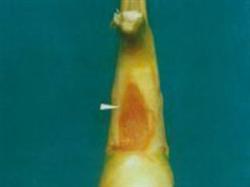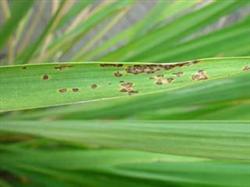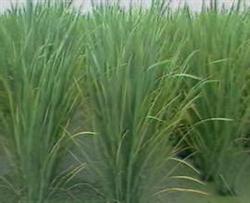Field management techniques of Zizania caduciflora

1. Reasonable fertilization Due to its long growth period, tall plants and more fertilizer requirements, Zizania latifolia is a kind of fertilizer tolerant crop, requiring sufficient base fertilizer and timely topdressing. Basal fertilizer: 35-40 loads of human and animal manure per mu (the same below), or 50 kg of ammonium bicarbonate plus 40 kg of calcium phosphate, mixed well and combined with deep harrowing. Topdressing: 10-15 days after transplanting, apply "seedling promotion fertilizer" once, apply 8-10 parts of human excrement or 25 kg of ammonium bicarbonate plus 10 kg of calcium superphosphate, but pay attention to applying ammonium bicarbonate in the cloudy afternoon about 0.2 cm away from the seedlings to prevent burning seedlings; 1 month after planting, apply "tillering fertilizer" again, apply 20-25 loads of human excrement or 10-15 kg of urea, promote early tillering and early pregnancy of Zizania latifolia, apply "pregnant Zizania latifolia fertilizer" again at the end of July, this fertilizer should be timely, apply too early plants green, apply too late to affect pregnant Zizania latifolia, generally master that 80% of the plants in the field are flat, apply when it can be seen that they are expanding, and apply 30-35 loads of human excrement or 15 kg of urea per mu. 2. Scientific irrigation should be determined according to the different growth periods of Zizania latifolia. After planting, Zizania latifolia L. is promoted to live in shallow water of 0.3 cm. With the growth of Zizania latifolia L. seedlings, the water layer is gradually deepened. Before tillering, 0.5-0.7 cm of water is maintained, and 1-1.3 cm of water is maintained at the later stage of tillering to control ineffective tillering. At the pregnant stage, the water layer should be deepened to 1.7-2 cm to promote white and tender flesh of Zizania latifolia L. 3, intertillage stripping leaves from planting to the closure period to carry out secondary intertillage weeding and a stripping leaves. Defoliation is mainly to strip old leaves, yellow leaves and diseased leaves from plants. Intertillage and weeding were carried out half a month after planting and before closing the rows to loosen the soil and eliminate weeds. 4. Pest control of Zizania latifolia mainly includes one disease and three insects: leaf embroidery disease, Zizania latifolia, aphids and white cicadas. In June and July, due to high temperature and high humidity, and leaf rust is easy to occur due to plant height and leaf luxuriant, it is generally possible to spray with 0.1-0.2 degree of stone sulfur mixture +800 times solution of new lipid membrane or 0.5% sodium rust +800 times solution of new lipid membrane. Zizania latifolia, aphids and white wax cicadas can be controlled by spraying 80% trichlorfon 100g+ dimethoate 100g mixed with 75 kg water and 800 times of new lipid membrane. 5. The standard of timely harvest is that when the three outer leaves are long, the heart leaves are short, the pregnant parts are expanded, the leaf sheaths are separated from each other, and the white flesh is exposed, the harvest can be put on the market. After the first harvest, be careful not to step on adjacent young rice. After the first harvest, quick-acting fertilizer should be applied once to promote the development and expansion of the second crop and improve the yield.
- Prev

Identification and control of sheath blight of Zizania caduciflora
[symptom characteristics] Zizania latifolia blast, also known as Zizania caduciflora gray heart disease, mainly affects leaves. Leaf disease spots can be divided into three types: acute, chronic and brown spot. The acute type of spot is dotted, dark green, and the gray-green mildew layer on the back of the spot (conidia and conidia) is more obvious, which is the precursor of the epidemic of Zizania latifolia white plague. The chronic spot is nearly fusiform.
- Next

Key points of autumn planting techniques of Zizania caduciflora
The autumn planting of Zizania caduciflora can make full use of the free middle (single) late field, double late field, medium and low yield field, low-lying waterlogged land, Zizania caduciflora field, etc., which can improve the yield and benefit of the first harvest year. Compared with the traditional spring planting of Zizania latifolia, planting Zizania latifolia in autumn makes full use of not only the free fields in winter, but also the long time in autumn.
Related
- Where is it suitable to grow horseradish in China? it is expected to see the middle altitude horseradish in Alishan.
- How to prevent tomato virus disease reasonably? (Control methods included)
- Many people like to plant towel gourd on the balcony. What are the main points of this method and management?
- What crops can chili peppers be mixed with?
- Fertilization techniques and matters needing attention in Tomato
- What are the grafting techniques for peach seedlings in spring?
- Harm and control methods of root swelling disease of Chinese cabbage
- What are the pests of sweet potatoes? How to prevent and cure it?
- Symptoms, causes and Control methods of navel Rot in Tomato
- The cause of "Cucumber rotten bibcock" in Farmers' planting Cucumber and its Control Plan

